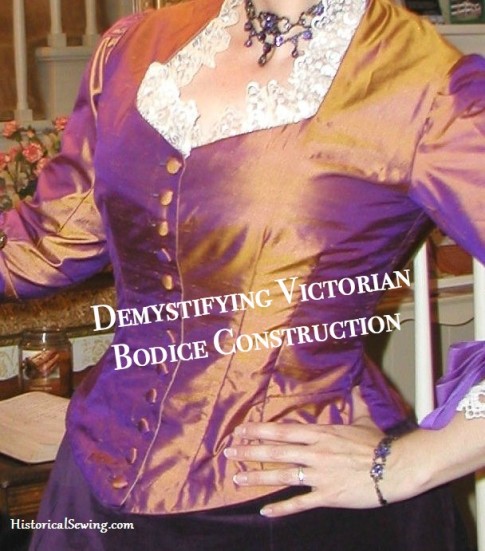 That moment when you are ready to jump into your first Victorian dress and hold out hope that it’s not as complicated as it “seams.”
That moment when you are ready to jump into your first Victorian dress and hold out hope that it’s not as complicated as it “seams.”
Because I’d been sewing clothes for about a dozen years before I got into historical costuming I wasn’t afraid. But so many I talked to in that early part of my journey said the bodices of the 19th Century were complicated. Difficult. Time consuming.
I agree and disagree.
First, yes, making a bodice of any decade from the 1840s forward takes time. Sometimes 40 or even 50 hours for that one garment. Depends on your overall design and speed of sewing.
I also agree that they can be complicated. Complex. Intricate. That’s probably why I haven’t yet attempted an elaborately draped mid-1890s Worth bodice reproduction with all those hidden and catty-wampus hook & eye closures. They are intense!!
However, I want to persuade you away from those thoughts that Victorian bodices are too difficult to make.
Because when you peel off the outer layers – the lace, the tucks, the ruched center panel, the bertha, the ribbon trim – there lies an inner structure, a foundation we can call it, which is nearly uniform throughout the era.
Let’s look at the construction of that basic foundation. We can shine a bright Edison light onto the basics of what makes one of these “complicated” bodices so we can be brave in our next project.
Let’s kick fear in the face because really…. They’re basically articles of clothing; they are simply a garment to cover our upper body.
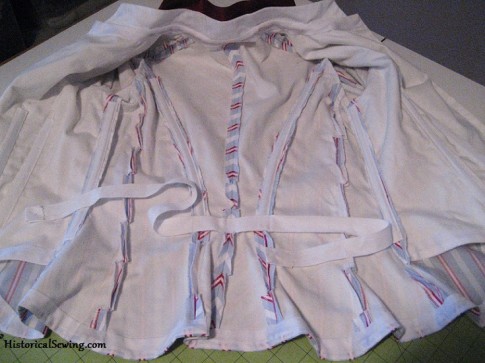
Now obviously, fit is HUGE when it comes to sewing a bodice. Maybe that’s why it seems difficult. For the sake of simplicity we’ll shelve the topic of fit for a few minutes and concentrate on the actual sewing.
Order of Sewing a Victorian Bodice – 10 Steps
1. Flatline main bodice pieces
2. Sew front darts
3. Sew main design seams (aka side front seams, all side back seams)
4. Sew shoulders and side seams
5. Flatline sleeves as desired and sew seams
6. Hem & trim sleeves
7. Add bones in casings to seams and darts
8. Set sleeves into the bodice
9. Sew bias around neckline and lower edge to finish
10. Finish with closures of buttons & holes or hook & eye sets (or tape)
That’s it! Doesn’t seem too hard, right?
Extra Sewing Tips
1. Flatlining your fashion fabric helps give structure and support for the tightly fitted bodice. It strengthens seams. It provides a foundation for trims (even heavy ones). Get detailed instructions on flatlining a bodice in the tutorial here.
2. Nearly all Victorian bodices have two front waist darts to shape the fabric over curves between bust and waist and hips (for those longer garments). For large bust cups or really curvy figures use three small darts in front. Use the darts where you need them. Sew them beautifully.
3. The main seams are simple seams. Sew regular seams and finish raw edges at this point with serging (my modern shortcut), hand whipstitch or binding. You could also pink the edges. Press seams open. I will say, some original bodices have seams pressed towards the center back, so they all weren’t pressed open. (Read more on seam finishes.)
4. Shoulder and side seams are like the main seams. Sew, finish raw edges and press open.
5. Not all sleeves need to be flatlined. Some light fabrics for summer could simply have a short sleeve lining and be sewn separately (not flatlined with the fashion fabric). Other sleeves, like 1890s full puffs, definitely need inner support. I recommend organdy or silk organza for nice structure here. After flatlining (or not), sew the main length seams (1 or 2 depending on the pattern).
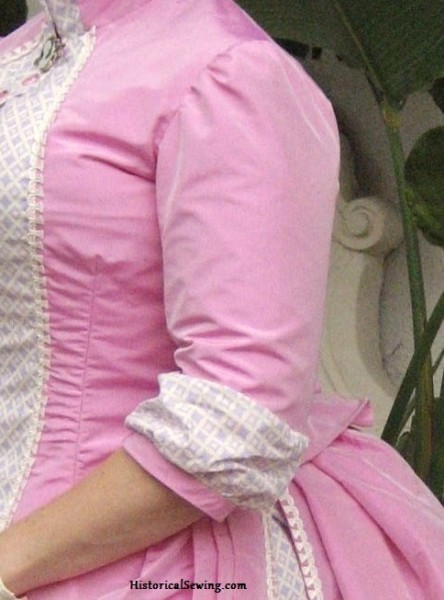
6. I like to finish the hem of my sleeves while they are still separate from the bodice. Just makes it all easier, right? Hem with bias tape (a common Victorian hem). Add cuffs and any other trim now.
7. Before setting in the sleeves you’ll want to add the bones to your bodice. Many costumers leave boning til last but it’s so much easier to apply to a bodice with no sleeves. Plus, bone casing can be sewn straight to the seam allowances of the bodice. Here’s how and where to apply the boning in 1870s & 1880s bodices, but this tutorial will work for other Victorian decades. You’ll want to apply bones to the darts too.
8. Set in the sleeves. You may dread this step. Don’t. I hear talk about “evil sleeves” so often it’s no wonder a smooth set-in eludes sewers! Don’t mentally set yourself up for failure.
My first step is to pick up one sleeve and try it on. Is it the left or the right? Once decided which arm it goes on, pick up your bodice and find that same side. Start pinning at the bottom most seam/notch at the underarm. Pin up to the easing or gathering stitches (if you have them), then pin the rest. Get a full video tutorial on setting in sleeves here.
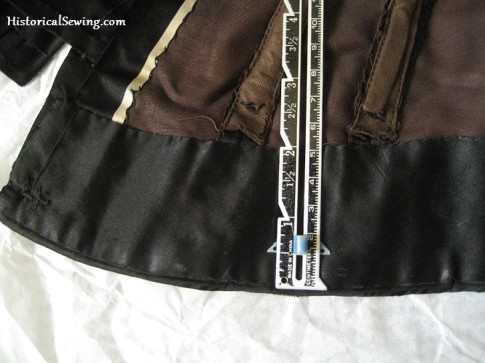
9. Raw edges along the neckline and lower bodice edge were frequently finished with bias tape on original Victorian bodices. (Sometimes you’ll see full linings but those were for expensive garments.) The bias tape finishing method was the most popular. Bias can be cut from the fashion fabric, the underlining fabric or another lining fabric.
10. Our last step is to add the closure. Evening bodices were sometimes closed at the back with individual hook & eye sets or hand eyelets & lacing. Front closing bodices had buttons with hand or bound buttonholes (I personally do them by machine) or with hook & eye sets. Hook & eye tape was used later in the 1890s and on.
To get buttonholes spaced evenly, mark the top and bottom holes first (look at originals for placements as they are not always near the finished bodice edges). Decide how many buttons you want on the opening. Measure the space between top & bottom marks and divide by the number of buttons you want minus 1. For example, if you want 10 buttons, divide the length by 9 which will give you the spacing between each button. Pin mark first before drawing in with pen/pencil.
Then your bodice is done! See? Easy.
The more detailed parts of bodice sewing come when you want a ruched panel or that draped bit over the shoulders. But essentially, the above 10 steps will get you through most any 19th C. bodice. Try it!
Do you have a set of steps you follow when sewing up a Victorian bodice? Share your tips and experiences below.

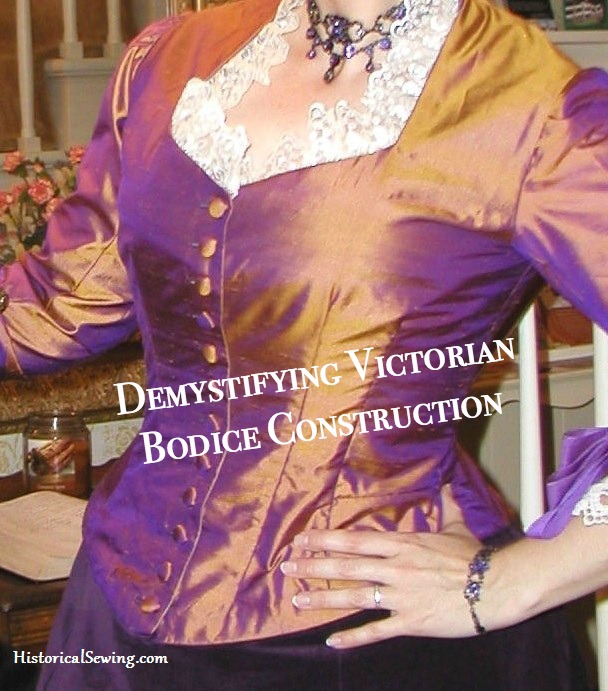
Hi thank you for the tutorial! the bodice in the picture where do I get that pattern? It’s very nice I’m about to delve in my first Victorian dress the place I work we all dress up Victorian 1890s every day!
You’re welcome. And how fun! The copper/purple bodice is modified from Truly Victorian TV428.
I’ve been reading ‘the authentic dressmaking techniques’ book and (if I’ve read correctly!) It seems to mention making the lining separately to fit and then attaching the bodice – if that’s correct how is the fashion fabric then attached? Is it constructed separately and then attached?
I’ve also seen the other method of sewing the lining and fashion fabric together at the same time (as in your photos) so I’m very confused! X
Love that book! My post here is on Victorian construction versus more Edwardian/early 20th century that is discussed in that book. So between that description of sewing the bodice and my post it depends on what time period you are sewing. Yes, starting in the late 1890s linings were made separately from the bodice then the lining whipped in. You can read more about linings in this post.
For sewing the lining and fashion fabric together, that is what I call “flatlining”, which you can read about in this post.
I’ve noticed that some buttons are very close together and some farther apart. Is there a rule of thumb for 1880s bodices? If they are close together is it more as a decoration?
No rule of thumb. Could be to provide more support for stress points (like the waist area). Or could simply be the dressmaker’s lack of proficiency in putting in evenly spaced buttonholes. 😉
Interesting article. I’ve got a question, tho. You said, that bodices close either on the back or on the front. Are there bodices that close on the side? Is it even possible?
I’ve not seen side closures in the Victorian bodices (1830s onward) until the evening bodices of the 1890s when draping was added. Even then, linings still closed at front or back with the plackets and other drapes fastened toward the side(s). A full side closure was not done, from my research, until early Edwardian years (after 1900). Then, side closures were much more common.
This may be an incredibly silly question or two, but one I’ve been wrestling with: a bodice looks (to me) a bit like a jacket – is it usual to wear a shirtwaist under it? Or is it when the bodice is open in the front?
Also, does the bodice have to be in the same fabric or similar to the skirt? Or did Victorians mix-and-match their fashions (as long as it didn’t clash)?
Any help would be greatly appreciated!
For one new to Victorian garments, yes, a bodice looks like a jacket. A shirtwaist (blouse) would not be worn under it. If a bodice has a lower neckline or “fill-in” front area, a chemisette or under-blouse could be worn. (Read more on those items in this post.) Layers would be: chemise (like a nightshirt to protect all other garments from body oils), corset, and *maybe* a corset cover then the lined bodice.
Victorians LOVED their colors and color combos! You can see the variety on my 1870/1880s Pinterest board, and my 1890s board. Earlier in the era – 1840s, 1850s and 1860s saw most ensembles with skirt and bodice in the same fabric.
Hi, I have problem with finishing edges on bodice. Could you make tutorial how to finish those edges nicely with bias? I mean the 9. step. I am making 1880s bustle dress. Your wedsite is so helpful, thank you! 🙂
For the bias finishing, it’s simply a bound edge. You sew the bias to one side, flip it over the seam edge and sew it down to the other side by hand or machine. You can read more on seam finishes, including the bias one, in this post.
What a great job you did. The bodice is lovely.
Marilyn
This thread has been dormant since August but on the off chance you find it, I have a question!
You say to put boning in the victorian bodice…is that taking the corset into account? Or is the tutorial just for the bodice?
A corset and bodice are both boned separately as they do different things. A corset supports the torso and smooths out the figure into an easy fashionable shape. The boning holds the corset fabric in place to provide the support. Bodice boning holds the bodice fabric in place and keep it from wrinkling around the shaped waist area. Even with a boned corset, if the bodice has no boning they is a good chance it will move too much as it’s worn and produce wrinkles. The bodice boning helps to keep it in place for the firm fit. 🙂
Hey, I am sewing a dress with a historically correct off the shoulder bodice from the 1860s… My problem doesn’t lay in the pattern or instructions though. I am 38″ bustline, 27′” ribcage with a highwaist line of 25″ and have taken in darts until they’re touching. I have also taken in side seams, but then it doesn’t lay correctly… I’m seventeen and a intermediate seamstress and have actually cried over this dress… Can you help?
Oh dear! I’d pull out the darts you have and re-pin in place. Make sure to use two on each side of center, or even use three darts to fit your large bust/small waist ratio. Good luck!
This site has been great for trying to understand a late 1800s Victorian dress I have been studying. Thank you!
One question – do you have any idea why there might be two buttons on the inside of the back “tail” of a bodice? I wondered if it was used to hold up the back of the skirt to produce or aid a pouf or bustle or for something else.
Buttons on the inside of the bodice at the waist? Are they original? My guess would be to button into the skirt waistband to keep the skirt from shifting while wearing (although, in my research this is generally on the front of the bodice rather than back, but buttons/hooks could very well be on the back too or instead of the front). Sometimes if the the bustle skirt is attached to the bodice for a one-piece dress, the buttons might be to bustle up the pouf with buttonholes or ribbons attached to the skirt back and then buttoned/tied onto the bodice buttons to create the bustled poufs.
I assume if drawstring to neckline to tighten is done when bias put on neck. Planning my bodice
Yes, you can run a drawstring through the neckline under the finishing bias. You’ll need to finish the opening a little different, though, to accommodate the string coming out at the ends. No biggie though.
Thanks for the tips! I was wondering if it would it be appropriate to add a modesty panel to the back closure of an 1850s dinner/ball gown bodice? I measured twice (as always), made a mockup, but the final bodice has a bit of pull/gap where it lays over the bulk of waistbands from the skirt, double petticoat, and cage crinoline. Any suggestions would be greatly appreciated!
Is the whole bodice opening up or just at the waistband? Yes, you can make a narrow panel but I’d put it along the entire bodice opening top to bottom. Make out of the dress fabric. Depending on the weight of the fabric, you could either hem the edges of the rectangle panel or line it by sewing right sides together and turning out. The raw edges on one long side need to be finished or tuned under then hand whip to the inside of the bodice where you can still access the closure.
The text book on dressmaking that I have that was published in 1894 talks about padding the bodice with cotton wool to “smooth the lines of the figure”. Do you ever do this? It also talks about when to stretch panels of the bodice to get them to fit better, and has an entire chapter dedicated to boning (and the various different types available at the time).
The padding is generally added to the top of the breast and partially to the front of the underarm to fill in the natural “dip” that occurs when wearing a corset. I’ve not added padding to my bodices as my corseted silhouette doesn’t seem to need it. I could do it though. You can build padding in a half-moon to full circle shape in layers like a shoulder pad. Use as many layers as you need for your particular figure.
Not sure I’ve heard of stretching panels to fit… at least not while un-sewn. The cut of the panels should be correct enough to not have to pull on the fabric. (my opinion)
Those period dressmaking manuals are wonderful resources for boning and notions!
About pulling on garment pieces to stretch them before sewing–modern patterns use the term “ease”, as a
verb, especially in sleeveheads and the inseam-crotch area of jeans. We don’t usually stretch the fabric before stitching, but we do pull on it a bit as we sew. When pinning the seam, one side is longer, so the fabric doesn’t lie smooth when pinned but the easing smooths it out. Another place where this easing/stretching is used is curved seams, beit princess seams, yokes, or just design elements. I haven’t had a chance to use an old treadle sewing machine, but I’d imagine they were a little less manageable and both hands were needed to keep the fabric going through the machine and the machine running–too much going on to stretch/ease the pieces together during the sewing.
I’m intrigued by this book! What’s the title & author name, I’d love to find a copy!
And let’s not forget that waist tape! I have a few bodices without, depending on the style and silhouette desired, but by far most of my bodices have one. I find it essential in achieving a good “tight” look.
Those hooks and eyes that will be connecting the bodice and matching skirt, if there is one, are also a good detail to keep in mind, especially critical if the bodice is short and barely (or not at all) overlapping the skirt.
Indeed!
I also have tutorials on waist tapes and those connecting hook & eyes. 🙂
I always set my sleeves in dead last. After buttons are sewn on, sleeves finished, neckline and bottom edge finished and decorated. It’s just easier, IMO. Then I tweak the garnish if needed, but I have the whole effect.
I admit I’ll even sew & tack the bias at the neckline and hem before setting in the sleeves. I know when I set in the sleeves and serge the allowances I am just about done. (Then I put on the buttons. 🙂 )
I never thought of placing the boning before setting in the sleeve. Great advice!! Will have to do this on my next project.
It is funny that this article came out today! I just finished the Truly Victorian “Hermione” overskirt yesterday and I am strting the TV 428 bodice today! I have made it up once before but I really needed the encouragement. I appreciate the advice on boning and bias tape. Thank you for your machine sewing tips as I always machine stitch when I can. Thanks, from Jeannine in Northern California.
Regarding measuring for buttons. I have a tool for that that I bought many years ago. It reminds me of the old drawing kit with the mechanical arm that you would trace a small drawing and the pencil in the other end drew it large. It is a tool that “scissors” out and has little “fingers” for where the buttons/buttonholes will go. You pick how many buttons you want to add, where you want them to start and end, and it “magically” divides the area perfectly for you to mark your button locations. I love it! I’d look for one of those if I was going to be doing a lot of buttons.
I’m glad you can use it! I didn’t include it here as I have one but mine doesn’t stretch out evenly. For me (and my perfectionistic ways) it was more frustrating to use so I went back to the method here. 😉